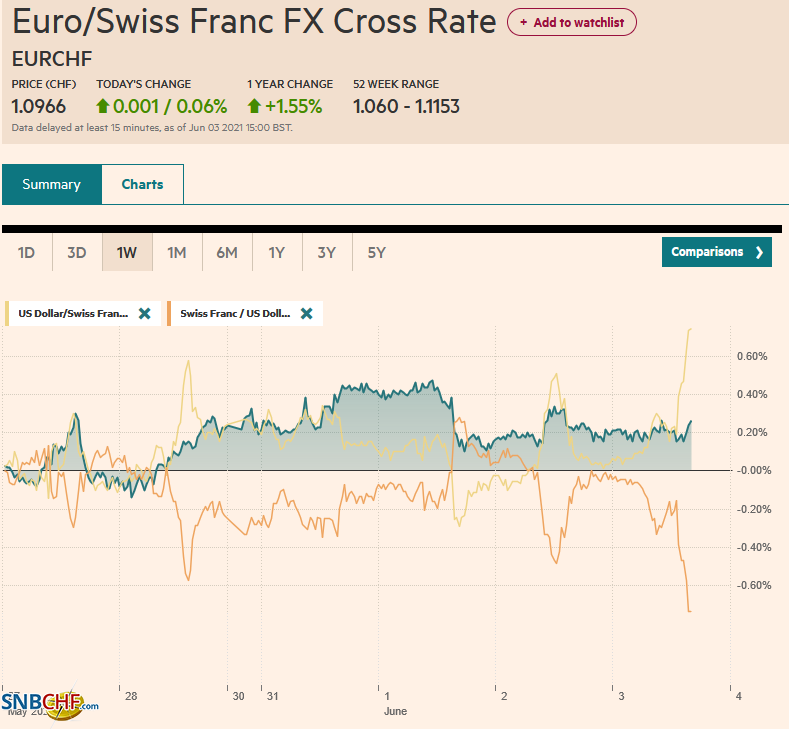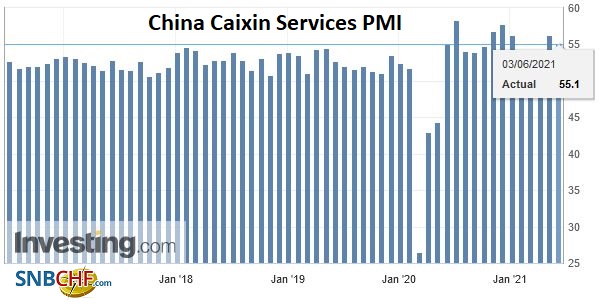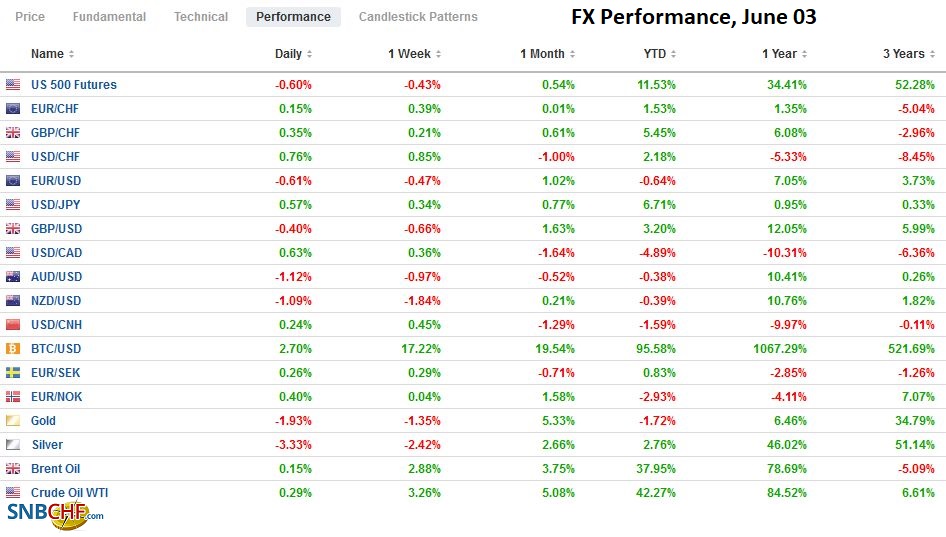Swiss FrancThe Euro has risen by 0.06% to 1.0966 |
EUR/CHF and USD/CHF, June 03(see more posts on EUR/CHF, USD/CHF, ) Source: markets.ft.com - Click to enlarge |
FX RatesOverview: Market participants appear to be biding their time ahead of tomorrow’s US jobs report as they digest recent developments. The dollar is firmer, equities are mixed, and benchmark bond yields are a little firmer. China and Hong Kong shares continue their recent underperformance, while most of the large markets in the Asia Pacific region edged higher. Europe’s Dow Jones Stoxx 600 is easing from record highs. The utility and materials sectors are the largest drags. US futures are on the downside by around 0.25%. US yields and the dollar did not sustain the increase inherited by North America yesterday, but the 10-year is testing 1.60% today from below, and European yields are 1-2 bp higher. For its part, the dollar has come back bid but in well-worn ranges. The Antipodeans and the Scandis are the softest, surrendering about 0.25% through the European morning. Emerging market currencies are also mostly lower, led by the Turkish lira, despite softer than expected May CPI (16.59% year-over-year down from 17.14% in April) and central and eastern European currencies. The heavier NOK tone is not a reflection of oil prices, which are firmer, with the help of a reported drawdown of 5.3 mln barrels by API. Other industrial commodities are firm. Iron ore has a five-day advance in tow, and steel rebar has risen in four of the past five sessions. Copper is posting is edging higher for the first time this week. Yesterday, lumber prices snapped a six-day 12% slide. Gold has already traded on both sides of yesterday’s range, and if its 0.8% decline is sustained, it would be the largest loss in three weeks. A break of $1882 would likely signal the end of the rally that began at the end of March near $1678. |
FX Performance, June 03 |
ChinaChina’s Caixin service and composite PMI missed expectations at 55.1 and 53.8, respectively. Although both slipped from April, they are still consistent with steady growth. The decline in Japan’s PMI moderated in the final reading, but both the service and composite remain below the 50 boom/bust level. The final service PMI stands at 46.5, up from the 45.7 flash estimate but down from 49.5 in April. The composite rose to 48.8 from 48.1 initially and 51.0 in April. |
China Caixin Services PMI, May 2021(see more posts on China Caixin Services PMI, ) Source: Investing.com - Click to enlarge |
Asia Pacific
Australia’s final PMI was also revised lower but remains strong. The service PMI stands at 58.0 rather than 58.2 as the preliminary estimate had it and 58.8 in April. The composite last stands at 58.0, a tad lower than the flash estimate of 58.1. It was at 58.9 in April. Separately, Australia’s trade surplus missed forecasts but was made up for by the upward revision to the March surplus. The April surplus was A$8.03 bln rather than A$8.3 bln, while the March surplus was revised to A$5.79 bln from A$5.57 bln. Exports fell shy of the 7% increase the median forecast in Bloomberg’s survey anticipated, rising only 3%, though the March decline was halved to 0.1%. Imports fell by 3% in April, and the March gain was revised to 5% from 4%.
Some observers had suggested that recent high-level meetings between US and Chinese officials were a prelude to a thaw that would lead to the resumption of formal bilateral talks and a meeting between Biden and Xi later this year. They saw confirmation of this de-escalation in Xi’s seeming pushback against “wolf diplomacy” with his advocacy of a “trustworthy, loveable, and respectable image” approach to the world stage. However, it seems premature to reach this conclusion. First, it appears Xi is speaking to a public relations challenge, not an issue of substantive policy. China’s local bullying continued in recent days, and Malaysia, for example, complained to China’s ambassador about the violation of its airspace by Chinese fighter planes. Second, the newfound push by the Biden administration about the origins of the virus can only antagonize Beijing, and such efforts, according to reports, will take years to really determine, not the 90-day deadline. Third, Biden is expected to shortly announce a new approach to banning investment in Chinese companies with military ties or involved with surveillance. Trump’s effort was challenged in US courts, and Biden will overcome these and put them under the Treasury Department. Biden is not giving up the chits Trump created but will put them on a more solid legal footing and strengthen them.
Japan’s 10-year bond auction earlier today saw the weakest demand in six years. The cash bond did not even trade for an entire session earlier this week. The dollar is firm within yesterday’s range (~JPY109.40-JPY109.90). A $1.38 bln option at JPY110 expires today. Its brief foray above JPY110, last week for the first time in nearly two months, was quickly rebuffed.
The Australian dollar tested the $0.7770 area in the past two sessions and met sellers. It is heavier today but held just above yesterday’s low (~$0.7715) and this week’s low near $0.7700. A break of $0.7675 would be important from a technical perspective.
The Chinese yuan softened. The dollar rose a little above CNY6.3960 for a new high this week. The official efforts have steadied the dollar but have not given it much of a lift. The dollar is up 0.35% so far this week, after falling over 1% last week. Note that China increased the quota for outbound investment, which ostensibly also helps ease the upward pressure on the yuan. With the unmistakable signals from officials, it is not surprising that policy banks were issuing dollar bonds onshore for the first time in several years, reducing the dollar liquidity. The PBOC set the dollar’s reference rate at CNY6.3811. The median forecast in Bloomberg’s survey was for CNY6.3797.
Europe
The final composite PMI for the eurozone was revised slightly higher to 57.1 from the flash reading of 56.9 and April’s 53.8. With the acceleration of the inoculation effort and relaxation of social restrictions, the eurozone economy is recovering from the contraction in Q1. The upward revision did not come from Germany or France, where the final service and composite PMI were identical with the preliminary estimate. Instead, other countries saw better than expected reports. Italy’s service PMI rose to 53.1 from 47.3, which was more than projected. The composite jumped to 55.7 from 51.2. Spain’s service PMI is the strongest of the large four EMU members, rising to 59.4 from 54.6. The composite stands at 59.2, up from 55.2.
The UK’s PMI has gone from strong to stronger. The service PMI stands at 62.9, up from the 61.8 preliminary estimates and 61.0 in April. The composite stands at 62.9. The initial estimate had to at 62.0 after 60.7 in April. Meanwhile, the UK may soon finalize a trade agreement with Australia, and progress is being reported on talks with India that could produce an interim agreement in H2 21. In addition, the UK and EU have reportedly reached an agreement in principle on the quote that can be caught from their jointly managed stocks this year.
The euro reversed lower on Tuesday and recovered smartly yesterday to settle above $1.22. It has better offered today but holding above yesterday’s low near $1.2165. It is trending sideways. A break of last week’s low (~$1.2135) is needed to signal anything important, but a close below $1.2180, the 20-day moving average for the first time in a month, may begin pressuring the short-term bulls. Still, ahead of tomorrow’s US employment data, consolidation may be the best that can be hoped for. There is a nearly 900 mln euro option at $1.22 that expires tomorrow.
Sterling is a bit firmer and did push briefly above yesterday’s high (~$1.4185) but could not resurface above $1.4200. The week’s high is closer to $1.4250. There is an option for almost GBP400 mln at $1.4240 that expires ahead of the weekend. Initial support is seen near $1.4140.
America
US May auto sales were softer than expected and eased below the 17.0 mln seasonally adjusted annual pace for the first time since February. It may have knock-on effects on the month’s retail sales. Shortages of supply and long delivery times appear to be the chief culprit. The Fed’s Beige Book, prepared for the FOMC meeting in the middle of the month, saw the economy accelerating in April and May. Businesses are anticipating rising costs and prices amid material and labor shortages.
The Federal Reserve announced it would begin to gradually divest the $13.7 bln of corporate bonds it bought last year. Some are claiming this to be the beginning of the normalization process. Yet, that is not what the Fed has said. Intent is an important element, like when the Bank of Canada reduced its bond-buying last year and shifted the buying to the longer maturities. It said it was not tapering, which is different from what it said at the April meeting. It also reduced its bond purchases. Similarly, if/when the Fed has to adjust the interest, it pays on reserves or the rate on its reverse repo operations to prevent further erosion in the effective Fed funds rate, it will explain it as a technical move, not a rate hike. That is how the move to sell its corporate bond portfolio should be seen. A housekeeping measure with no policy signal. Moreover, the Fed is buying $120 bln a month in bonds. The $13.7 bln corporate bond sale, gradually executed, will hardly be a rounding error on the Fed’s balance sheet.
The focus is on US jobs, even ahead of tomorrow’s national report. Today features the ADP estimate, which did not prepare the market for last month’s shock, which is subject to revision tomorrow. The median forecast in Bloomberg’s survey is for a 650k increase, in line, as it were, with the median projection for tomorrow’s nonfarm payroll report. In addition, weekly initial jobless claims are expected to have fallen below 400k. The four-week average was 823k around Xmas last year. It stood at 458k in the week through May 22, and it will fall further with today’s report. Separately, the US also sees the finals service and composite PMI and the ISM services index.
The US dollar continues to bounce along its trough against the Canadian dollar. The range is marked by tomorrow’s option expirations. A $970 mln option is at CAD1.20, and around $325 mln is at CAD1.21. With around three rate hikes discounted over the next two years, the Bank of Canada, which meets next week, may emphasize the uncertainty and uneven recovery, especially if the jobs are lost for the second consecutive month when May’s employment report is released tomorrow.
The market is also aggressively pricing in around 100 bp in hikes by Mexico over the next year. There is some talk of a first hike, possibly at the end of the summer. Yesterday, Banxico revised this year’s growth (6.1% from 4.8%) and CPI (4.8% from 3.6%) projections. The dollar is moving broadly sideways against the peso. It has not closed above MXN20.00 since May 12. The greenback has not settled below MXN19.86 since May 17.
Graphs and additional information on Swiss Franc by the snbchf team.
Full story here Are you the author? Previous post See more for Next postTags: #USD,$CNY,Banxico,China,Currency Movement,EUR/CHF,Featured,federal-reserve,jobs,newsletter,PMI,USD/CHF





























